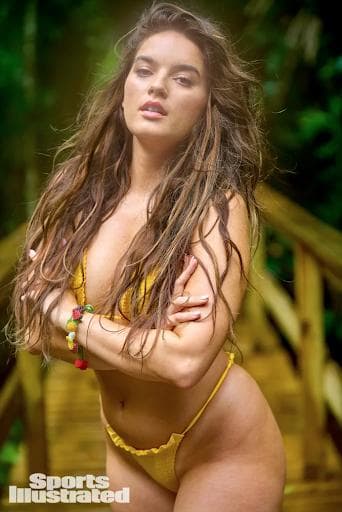Pura Utz Connects People Through Cratsmanship
Pura Utz, a Copenhagen-based jewelry brand crafted in Santiago, Guatemala, is much more than their simply swoon-worthy creations. Eight years ago co-founders Anna Andrés and Bernabela Sapalú embarked on a mission of wanting to provide full-time work and income to a team of women in Guatemala. Pura Utz has enabled these women to be financially self-sufficient when they otherwise may have been unable. SI Swimsuit featured some of the brand’s pieces in its 2022 photo shoot in Belize (see Jasmine Sanders and Natalie Mariduena below).

Jasmine Sanders was photographed by Yu Tsai in Belize. Swimsuit by White Shore Swim. Earrings by Cleopatra’s Bling. Necklace by Pura Utz.
Shop necklaces by Pura Utz: Chunky Strawberry Necklace ($897)
View Jasmine Sander's full 2022 gallery here.

Natalie Mariduena was photographed by Yu Tsai in Belize. Swimsuit by INDAHBracelet by Pura Utz.
Shop bracelets by Pura Utz: Fruit Salad Galore Bracelet ($171).
View Natalie Mariduena's full 2022 gallery here.
We wanted to take a closer look inside the company’s inspiring mission so the Pura Utz founders gave us the scoop:
How did Pura Utz get its start?
Anna founded the project and brand eight years ago after having lived, traveled and worked in Guatemala since she was a child. It was founded on the values of empowerment, meaning that Pura Utz could be a vessel for income for women working in a more equal relationship where their talent would get recognition and support their self-esteem through providing for themselves. About six years ago Anna and Bernabela met and became close friends, and two years later decided to co-found Pura Utz together in Bernabela’s house. Anna is a trained nurse and Bernabela a self-taught artisan. Today, Elisa, who is Bernabela’s daughter, runs the business alongside Bernabela and Anna.
What does the name “Pura Utz” mean?
It means Pure Quality or Pure Good and is derived from Spanish and Mayan dialect. It also serves as an expression of amazing or super great.
Who are the women who make up the Pura Utz team?
Outside of our three founders/owners, we have Julia and Chonita, our head of sampling, development and training. And then we have the main talent on our team: Rebeca, Jenny, Sara, María, Letty, Lucía, Rebeca, Antonia, Chico and Brayan. (Yes, we now have two men on our team as well.) They come to the workshop (almost) every day, Monday through Friday, to work. Some are almost continuously working on samples and others in production. Several from our team work from home as they have household responsibilities, so they usually stop by once a week to pick up materials.
From start to finish, how long does it take to make the hand-beaded products?
That varies a whole lot. One of our mini fruits now takes only 10 minutes (they took an hour when we started), but a Flower Dream Bag takes up to four days. That is because we now divide it between four women who make different parts of it and one who assembles it at the end. When we were making them one by one, they took at least seven days.
Where do the beads that comprise the accessories come from and how do you source materials?
We use glass beads from Czech Republic and Japan. It’s the best quality glass bead, both for shape, size and manufacturing.
Where does the inspiration for the playful designs come from? Are they tied to the Guatemalan artisans’ roots in any way?
Guatemala is a super colorful and vibrant country for sure. All the women in our team wear traditional dresses adorned with birds, butterflies and flowers. Nature is blossoming and volcanoes are all around, so it is for sure super inspiring to be there. But we do like to be honest about our inspiration and about the fact that our designs do not resemble the ‘typical’ artisan designs nor honor the tradition in that sense. Our main inspiration comes from artisan craft techniques; what can we create with the techniques that can be fun, relevant and great quality? Something that is unique and stands out so that people will want to buy and we can support our team. So our main inspiration is in that part of our design process. What is possible with this amazing craft technique and talent? And then of course it has to be relevant on a bigger international market so that people actually want to buy our product and that it lives up to its price and promise.
Was there a specific instance or memory of when it became clear that Mayan craftsmanship could attract interest from all over the world?
Bernabela lifted herself out of a background and upbringing with very limited resources. It has been her main way of income and she has been determined to make a good income from her craft always. Her own experience in working many places had been that she was treated very poorly and paid likewise, but she always believed that she could come out ahead if she kept moving forward. She proved this by putting her daughter through school and university (the first one in her family). Anna had been involved in volunteer work for many years but came to the realization that maybe that work was serving her more than the people involved because of the short-term involvement and the fact that what she wanted to teach and pass on was maybe not relevant at all. It was much more about the women having limited access to income and self efficacy, so that is where the idea to co-create designs to bring to an international market emerged. Artisan work and designs are often very devalued in a local context, so that is why we are bringing them to the international market.
What was one of the biggest challenges of creating a brand dedicated to complete transparency and fair trade?
The biggest challenge first and foremost was that we did not know anything about having a business. It was a completely different relationship to develop because there is a transactional relationship that you can’t deny. We lost so much money the first many years through terrible sampling but still paid everyone involved. We chose to be a business over being an NGO because in our experience there was a limit to the prosperity of our team and leisure we could have in our everyday life in the workshop. We also believed that it would create a more equal relationship between the women and the consumer because we took out the aspect of buying for charity (which feels so off when you know that the women in our team are the madly talented and resilient ones). It is our belief that it is more empowering to make your own money and to provide for yourself, but the bigger capitalistic system we are part of is difficult for us to navigate. Our products turn out medium to super expensive because we want to pay super well in Guatemala, but at the end of the day the prices serve the consuming/selling end of the value chain, and I think that will always feel icky and strange. That is something we talk about a lot and are on a continuous journey to explore.
How do you achieve the balance of creating a company as focused on success as it is on accountability and doing good?
We have open conversations about everything, we talk so much. We talk about all the icky feelings, we talk openly to the team about value chains, earnings, pricing and everything in between. We get super disheartened when we focus too much on the bigger conversations we are part of because I simply think it's utopian to believe we ‘are doing good’ just because we pay well - the climate of the world and the capitalistic systems we are part of requires more from us we think. But we talk about this and then we focus on what’s on the plate in front of us and that is our team: are they happy, do they have a safe and happy workspace, do they eat well, are their families prospering and do they enjoy what they do? Other than that we have just taken the first initial steps towards B-Corp certification to test our business model and to hopefully get certified and figure out where we have work to do.
What is Pura Utz’s long-term goal?
Our long-term goal is to create the most beautiful production place in Santiago, we are constantly exploring new craft techniques and products. We have been renovating and expanding Bernabela’s house through the years, but our goal is to build a new place by the lake that can serve as a place of multiple funnels of work and to prove that it is possible to have the producing end of the value chain be the most beautiful. But that will take years as we are 100% self-funded. We will have to sell a lot of banana earrings to achieve this.
